Monthly Archives: July 2024
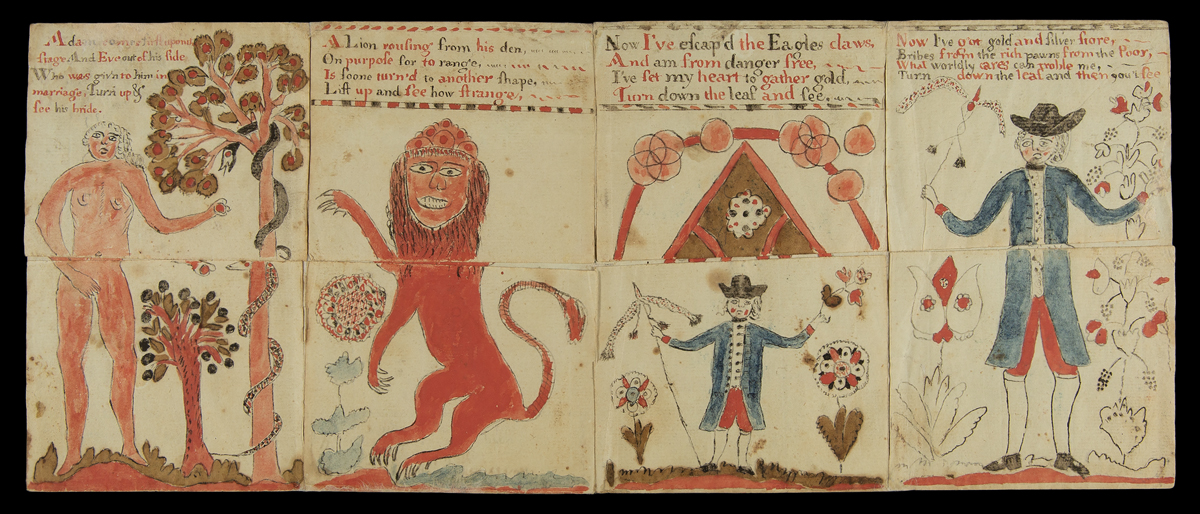
Metamorphosis Turn-Up Book, 1790-1820 / THF715860
Boxed and tucked away for many years in the Benson Ford Research Center archives at The Henry Ford, this turn-up book has found a new life — a metamorphosis — much like its title. This "book" — a sheet of cut and folded paper — engaged the reader in tactile learning and instilled moral lessons in interactive ways, conveying lessons and meaning through visual images and texts that change with the lift of a flap.
Movable and Turn-up Books
For hundreds of years, artists, illustrators, publishers, designers, and paper engineers have added motion and 3-dimensional depth to the flat pages of books and other paper-based media. Early examples of movable books date to the thirteenth century and involved the use of volvelles — a movable paper disk or wheel — and flaps. Designed as teaching tools for adult learners, scholars of science, religion, and philosophy manipulated these movable elements to predict astronomical events, plot yearly spiritual holidays, teach anatomy and other medical disciplines, and aid navigation, among other uses.
Eighteenth-century transformations in childhood education from strict rote learning to a more active model made movable books an appealing option for teaching children. By the mid- to late 18th century, publishers began selling printed flap or turn-up books for a wider readership that included adults and children. These sheets of cut and folded paper lured readers to interact with its pages filled with stimulating images and poetic texts that changed when readers lifted or folded down flaps. In the United States, printed versions of Metamorphosis or A Transformation of Pictures with Poetical Explanations for the Amusement of Young Persons presented a series of moral tales on movable pages and, as the title states, were directed toward a younger audience.
Metamorphosis
Metamorphosis or A Transformation of Pictures with Poetical Explanations for the Amusement of Young Persons traces its origins to earlier turn-ups such as the mid-1600s English publication The Beginning, Progress and End of Man. These early turn-ups instilled religious and moral lessons (and perhaps exposed political preferences as well) through images and verse — aspects that later authors copied, modified, and recontextualized in printed and handmade versions.
The Henry Ford's handmade version of Metamorphosis or A Transformation of Pictures consists of four panels and dates from the late 18th or early 19th century. Each panel contains two intersecting flaps; one turns up, the other down. Panels transform not once but twice, imparting moral lessons through religious, mythological, and heraldic iconography and poetic texts. First, Adam in the Garden of Eden changes to Eve — who then transforms into a mermaid. Next, a lion transforms into a mythical griffin and finally into an eagle, grasping a young child to carry him off. The third panel depicts the grown child as a young man eager to make money no matter the cost. The last panel shows what awaits the man who follows such a path: disease and death.

The first panel shows Adam in the Garden of Eden. The verse begins:
Adam comes first upon the
stage And Eve out of his side
Who was giv'n to him in
marriage, Turn up &
See his bride.
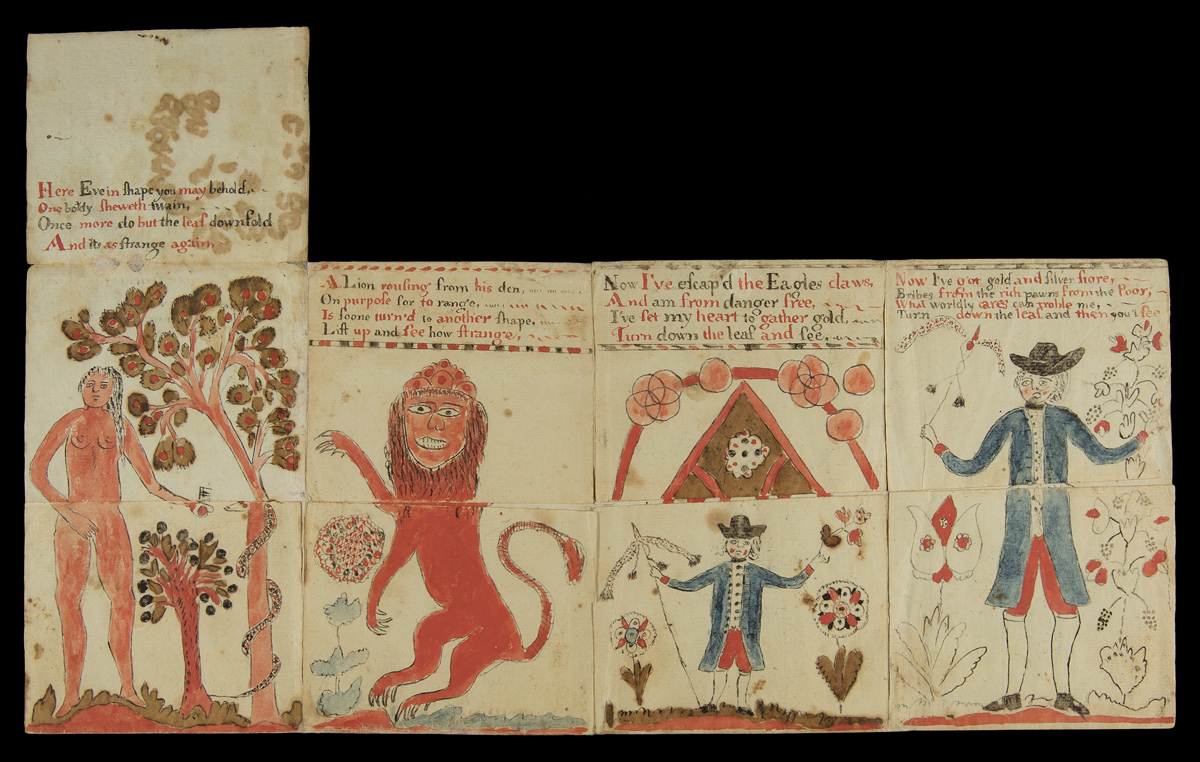
As the reader lifts the flap to reveal Eve, the verse continues:
Here Eve in shape you may behold,
One body sheweth twain
Once more do but the leaf downfold
And its [sic] as strange again,

Next, the reader turns down the flap to reveal a "marmaid," as the verse concludes:
Eyes look not on the marmaids [sic] face,
Let ears forbeare [sic] her song.
Her features hath an aluring [sic] grace,
More charming than her tongue.
It is unfortunate that the artist and owner histories of this Metamorphosis turn-up book have been lost. Similar handmade versions from the early 1700s to the late 1800s in other library collections exist, with only some including an artist's name. These examples have been an invaluable source for researching our copy. Curators at The Henry Ford — examining the book's form, texts, and imagery, including stylistic clues in the man's dress and the ornamentation on the later panels — believe this turn-up book may have been made in Pennsylvania, sometime between 1790 and the first decades of the 1800s.
Speculation continues about the artistic origins of this book. Was this made by a young woman as part of her education, promoting art and writing skills that would aid her later in life, or was this something a new mother crafted for her children to reinforce moral lessons? What we do know is that this once-hidden gem is part of a larger collection of turn-up books scattered in museums and libraries across the nation that may shed light on the beliefs, educational practices, and life of Americans in the early years of the republic.
Resources
For more information and to see other turn-up books like the one in the collection of The Henry Ford, see the following:
"Learning as Play: An Animated, Interactive Archive of 17th- to 19th- Century Narrative Media for and by Children." The Pennsylvania State University, 2019. https://sites.psu.edu/play/
Sperling, Juliet. "Unfolding Metamorphosis, or the Early American Tactile Image." American Art, 35, (3) 58-87. 2021.
Reid-Walsh, Jacqueline. "Format and Meaning-Making in Religious Turn-Up Books: The Remediation of The Beginning, Progress and End of Man into Metamorphosis, or a Transformation of Pictures: With Poetical Explanations for the Amusement of Children." [Chapter 10] in Forms, Formats and the Circulation of Knowledge: British Printscape's Innovations, 1688-1832. Ed. by Louisiane Ferlier and Bénédicte Miyamoto. (Library of the Written Word, 83; The Handpress World, 64.) Leiden and Boston: Brill. 2020.
Andy Stupperich is an associate curator at The Henry Ford.
A Wooden Quilt for Big Mama
In 2023, The Henry Ford acquired an incredible piece of art: a wooden sculpture by New Orleans artist Jean-Marcel St. Jacques, entitled “A Wooden Quilt for Big Mama.” The wooden quilt weaves together many threads from both St. Jacques's own family history and the stories already told in the institution's collections.
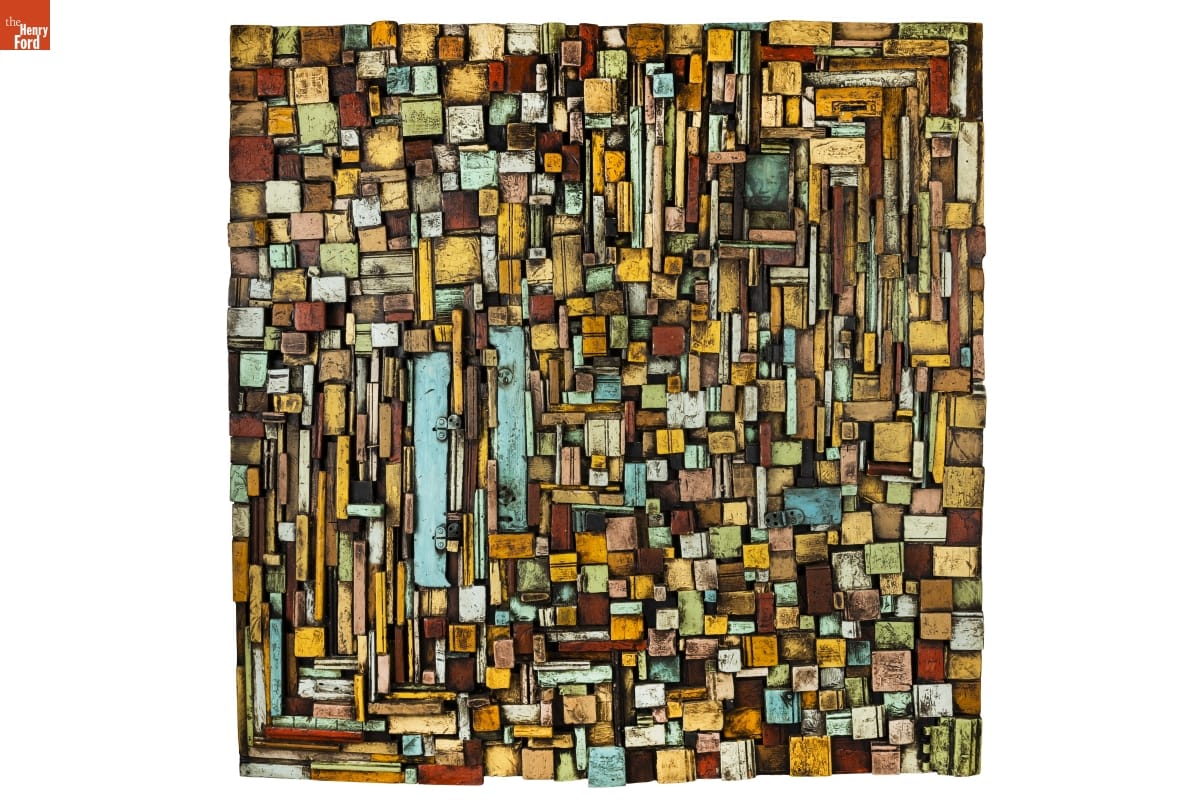 "A Wooden Quilt for Big Mama" by Jean-Marcel St. Jacques, 2023 / THF197819
"A Wooden Quilt for Big Mama" by Jean-Marcel St. Jacques, 2023 / THF197819
Jean-Marcel St. Jacques is a twelfth-generation Louisiana Afro-Creole. In the 1970s, his family left Louisiana for California, hoping to escape the racial oppression they faced in the South. Looking to reconnect with his family's roots, in 2004, St. Jacques moved back to the Tremé neighborhood of New Orleans, purchasing a former boarding house that had been owned by a woman known to the community as Mother Sister. One year later, however, Hurricane Katrina ravaged the Gulf Coast, particularly New Orleans. St. Jacques's home, along with many others, was severely damaged.
St. Jacques describes how the storm became a defining moment in his life, writing: “The last decade and a half of my life and work has been defined by the aftermath of Hurricane Katrina. The force of nature that blew the roof off of my house and forced me into a silent meditation and communication with my ancestors.” Using wood and other architectural fragments he salvaged after the disaster, St. Jacques began creating sculptural wooden art pieces -- doors, wall hangings, and his larger “quilts” — piecing together fragments and hardware, adding vibrant colors, and weaving in references to his family history. His great-grandmother Laura Agnew had been a quiltmaker, while his great-grandfather had been a junk man, gathering and reselling pieces he found, as well as a hoodoo man, practicing syncretic spirit work. St. Jacques considers his workshop to be “an ancestor shrine,” and keeps his great-grandmother's quilts and great-grandfather's tools nearby as he works.
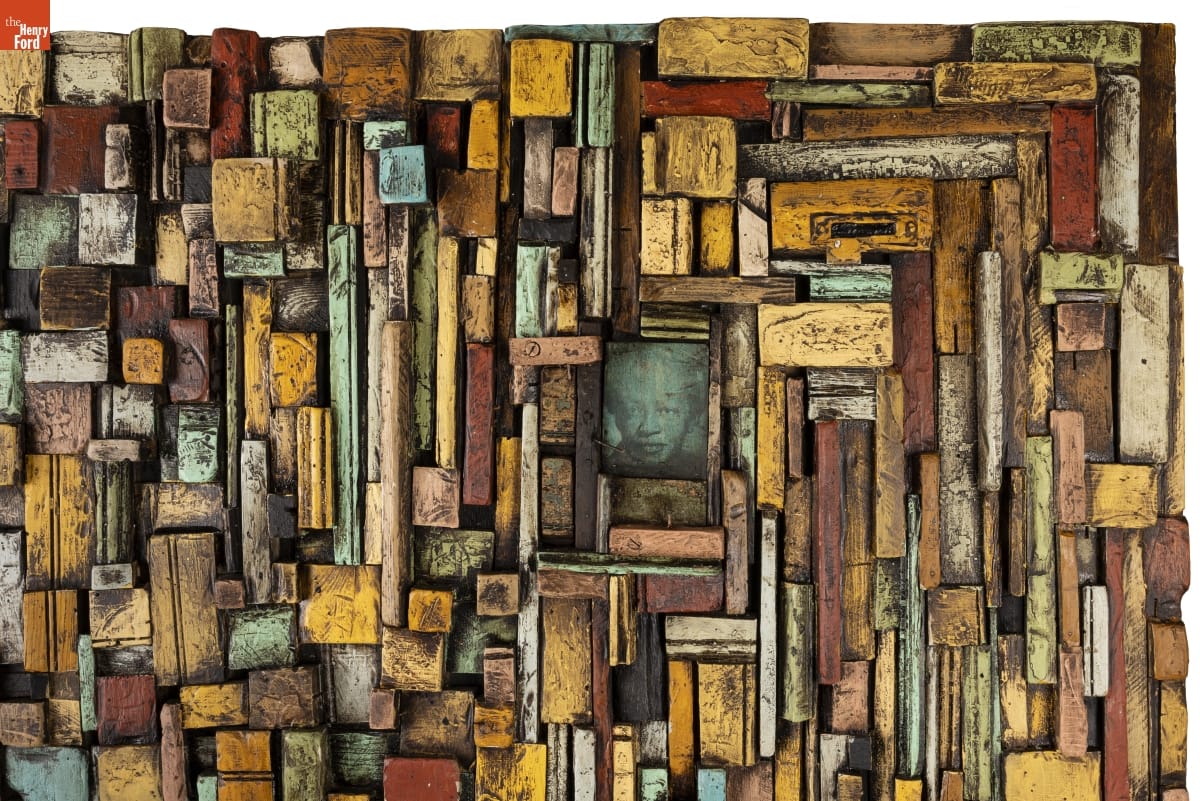 Detail from "A Wooden Quilt for Big Mama,'' featuring a portrait of Laura Agnew, the artist's great-grandmother / THF197824
Detail from "A Wooden Quilt for Big Mama,'' featuring a portrait of Laura Agnew, the artist's great-grandmother / THF197824
While every one of his pieces honors his family history, St. Jacques wanted this piece to be a special tribute to his great-grandmother, whom he called “Big Mama.” Amongst the hardware and painted wood blocks that make up the piece, there is a printed portrait of her tucked in the upper right-hand quadrant.
St. Jacques's wooden quilt not only connects to his great-grandmother's quilting practice, but to the practice of other quilters already represented in The Henry Ford's collections — particularly the work of quiltmaker Susana Allen Hunter.
Susana Hunter lived in Wilcox County, an impoverished, rural area of Alabama. She was an improvisational quilter, making up her quilt designs as she went along, often using material taken from clothing and fabric she and her family used, as well as material given to her by others. The quilt below features fabric that likely came from the clothing her husband Julius wore as a tenant farmer — denim overalls and flannel shirts — and is backed with material from mule feed sacks. The quilt not only reflects Hunter's improvisation and creativity, but also captures the history of her family through the physical material — much like St. Jacques's wooden quilt.
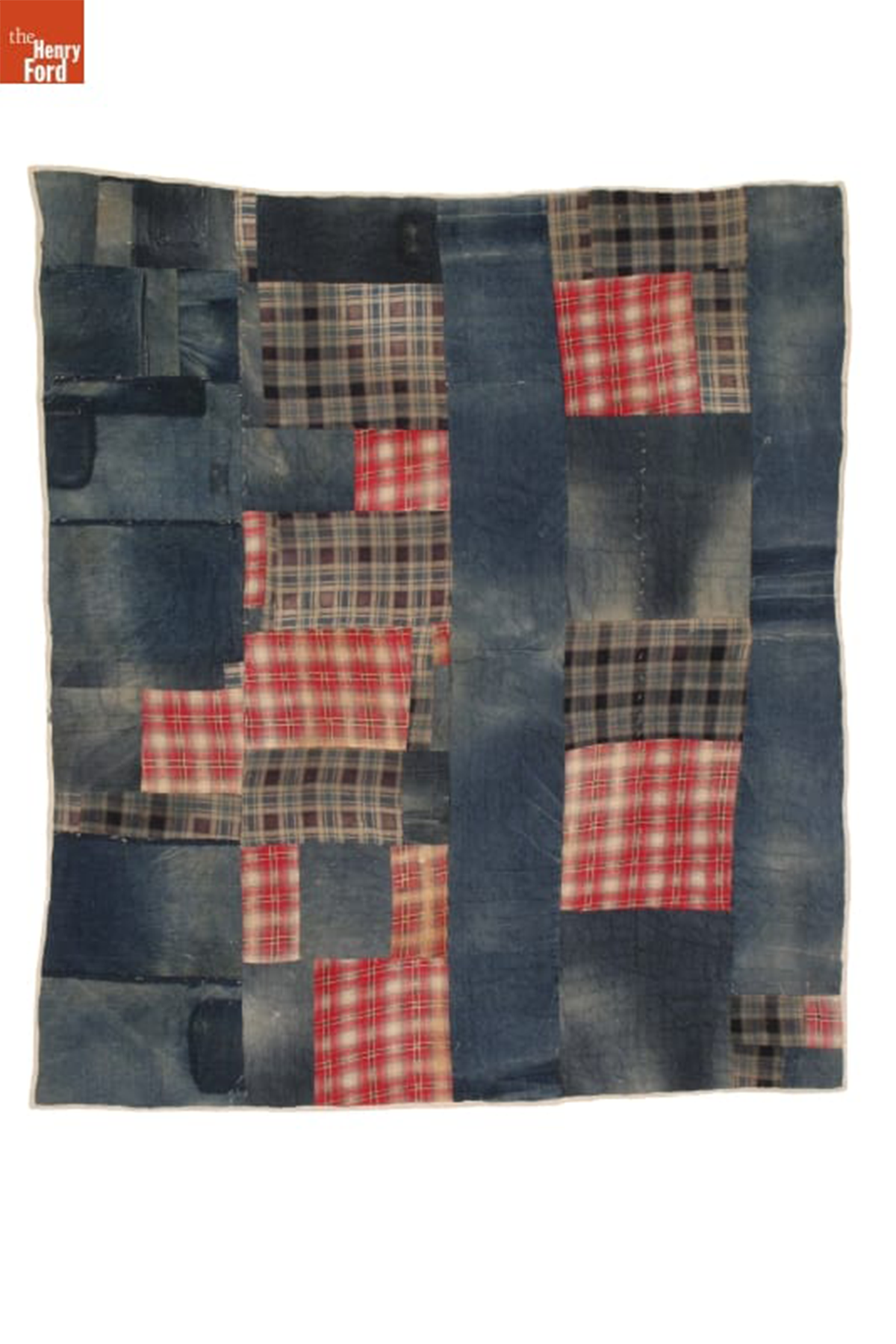 Strip Quilt Made of Work Clothes by Susana Allen Hunter, 1965-1970 / THF73636
Strip Quilt Made of Work Clothes by Susana Allen Hunter, 1965-1970 / THF73636
Acquiring this wooden quilt continues The Henry Ford's long tradition of collecting American folk art. Henry Ford's personal interest in what we would today consider folk art created the foundation for a collection that now stands at nearly 2,000 pieces, and includes works by such noted artists as George Washington Mark (1795-1879), Ammi Phillips (1788-1865), and William Matthew Prior (1806-1873). St. Jacques's work further enriches this collection, updating and diversifying it in a way that honors the folk art tradition.
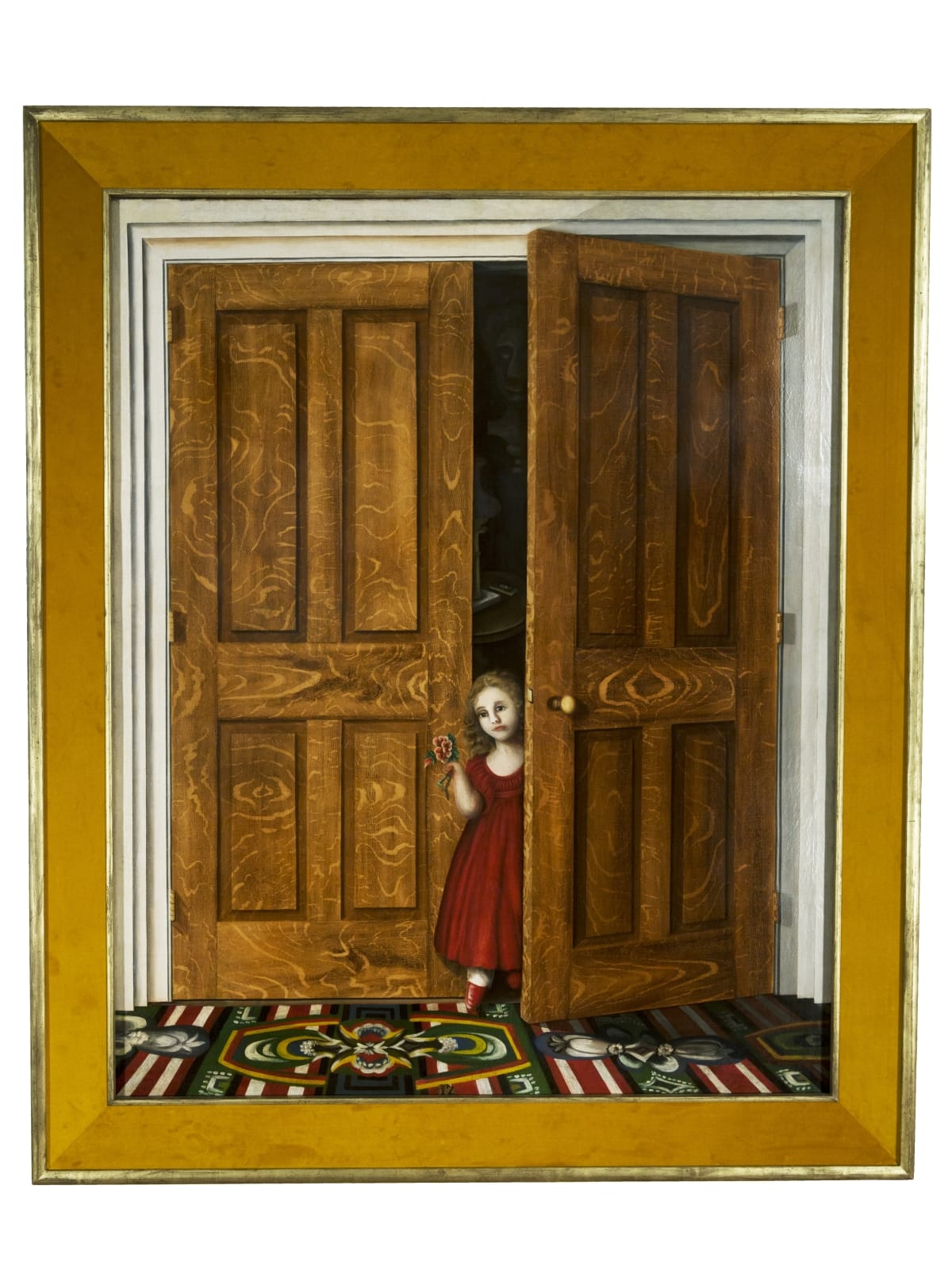 "Opening the Door," considered painter George Washington Mark's masterpiece, is one of the highlights of The Henry Ford's folk art collection. / THF172048
"Opening the Door," considered painter George Washington Mark's masterpiece, is one of the highlights of The Henry Ford's folk art collection. / THF172048
Every object in The Henry Ford's collection tells a story about past lives, be it directly via pieces connected to specific individuals, or more generally with objects that demonstrate life in different time periods. It is a special honor to be the institutional home for a piece like “A Wooden Quilt for Big Mama” — a piece that honors the life of the artist, his family, and his community — and to share with the public the rich stories it holds.
Rachel Yerke-Osgood is an associate curator at The Henry Ford.
Clara Ford’s Travel Diaries
When traveling today, it is easy to document our journey through swift clicks of our phones and cameras. The people, sights, and sounds of a moment are captured and recorded through photos, videos, and social media posts making it easy to reflect on where we were and what we enjoyed.
The desire to document a memorable trip has remained a common tradition and in the age of Clara Ford, was accomplished through travel journals or diaries. Even with the advent of photography, film had to be thoughtfully allocated to document the most meaningful memories from a trip.
The Henry Ford's collections include several travel diaries written by Clara Ford dating from 1912 to 1945. Clara did not keep a diary for every trip she took. As the wife of Henry Ford, her travels were frequent and varied. Most of the diaries document her travels overseas, a momentous journey for anyone at that time, and winter retreats to Richmond Hill, Georgia, and Fort Meyers, Florida.
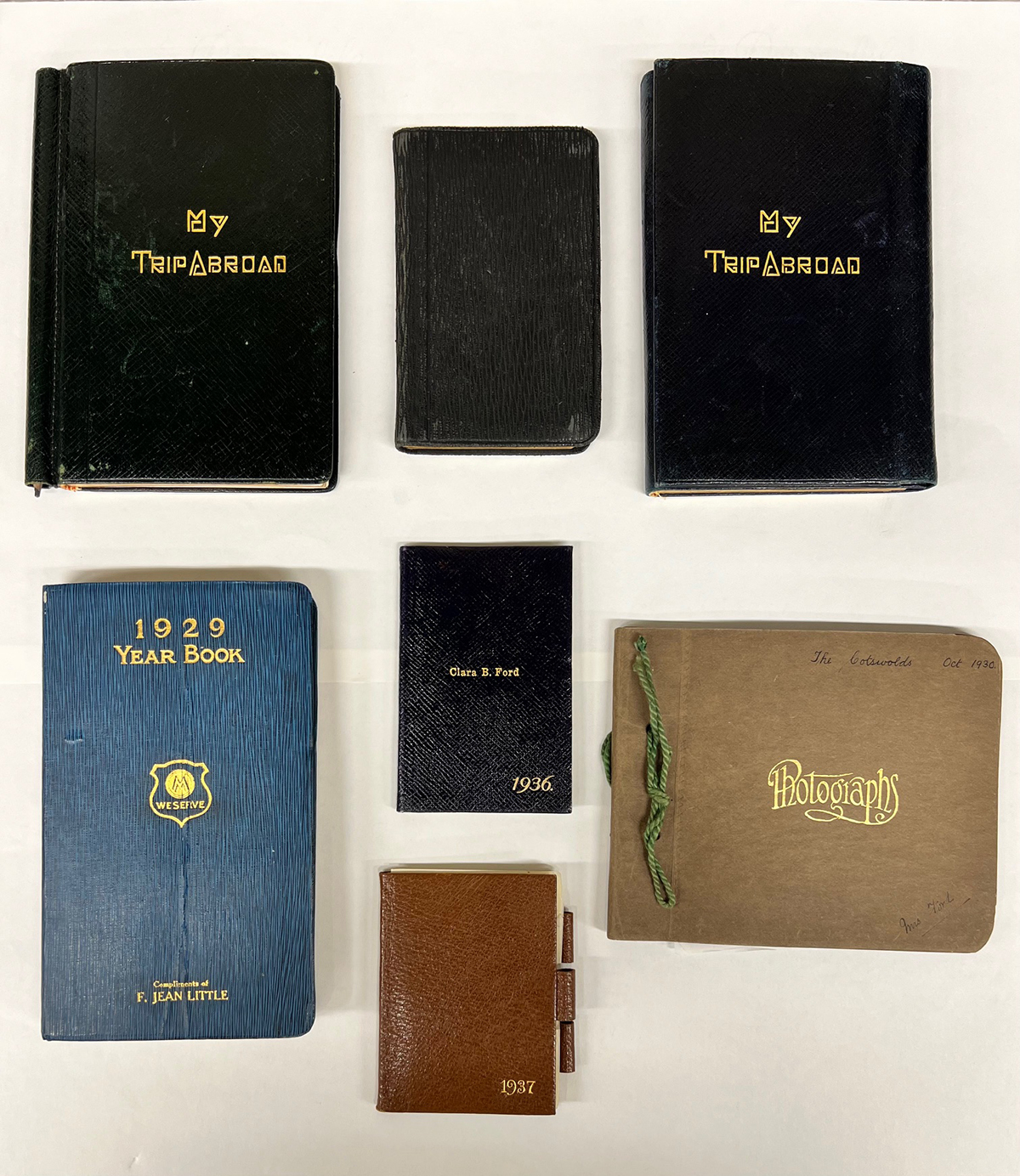
Clara Ford Travel Diaries. Accession 1, Box 105 and 106. / Image by Lauren Brady
Unlike social media posts, travel diaries were not always intended for sharing or future publication. Entries were meant to document travel details and for personal reflection.
This means the writer was often sharing their thoughts more freely. For a notable figure like Clara Ford, travel diaries provide insight into her personal opinions and interests that might have been left out of an official record of her travels. They also provide a valuable record of Clara at a given time and place. They tell us who she interacted with, where she stayed, and what she saw.
The earliest travel diary penned by Clara was for her first trip to Europe in 1912. She, Henry, and Edsel explored sites throughout Great Britain and France.
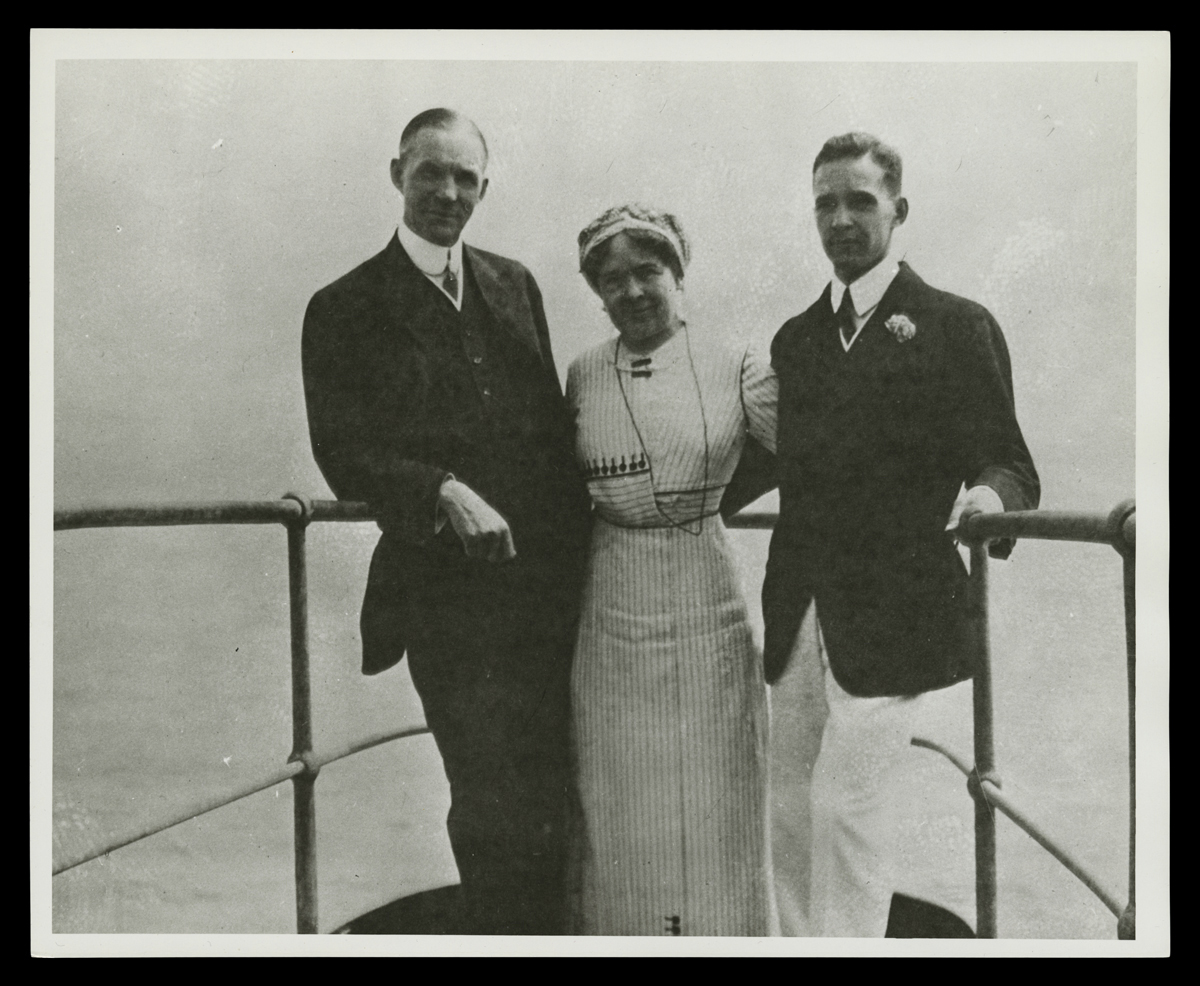
Henry, Clara, and Edsel Ford aboard Ship on their European Trip, 1912. / THF117563
In one of the first entries, Clara documents the time the ship set sail and describes the warm welcome they received. Among flowers, fruits, and candy were several letters from friends wishing them a “Bon Voyage!” Clara references a letter from her close friend, Lulu Wilson, which we also hold in our collection. Connecting archival records like these illustrates a larger picture for historians and researchers.
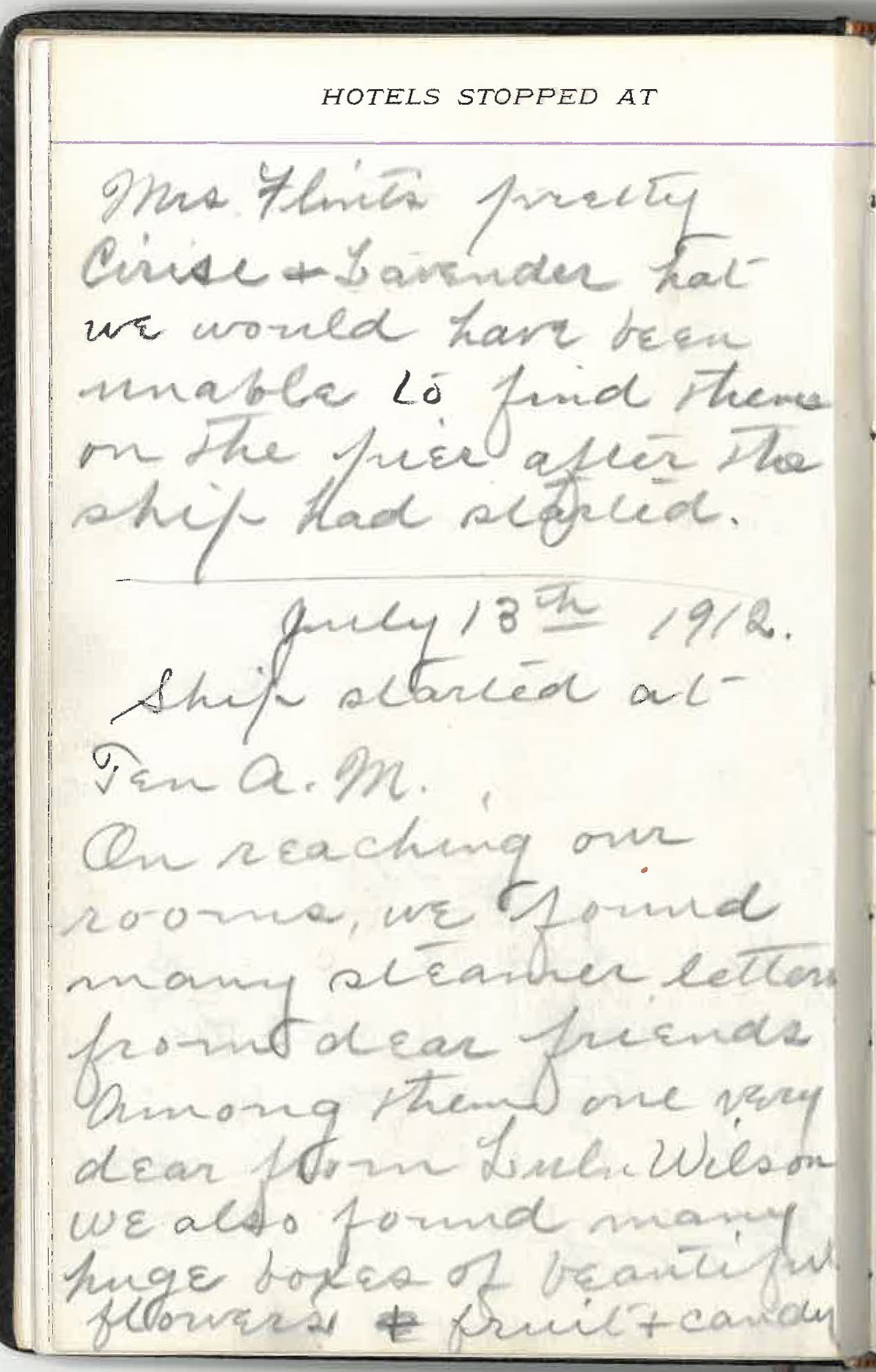
Clara Ford's Travel Diary, 1912. Accession 1, Box 106. / Image by Lauren Brady
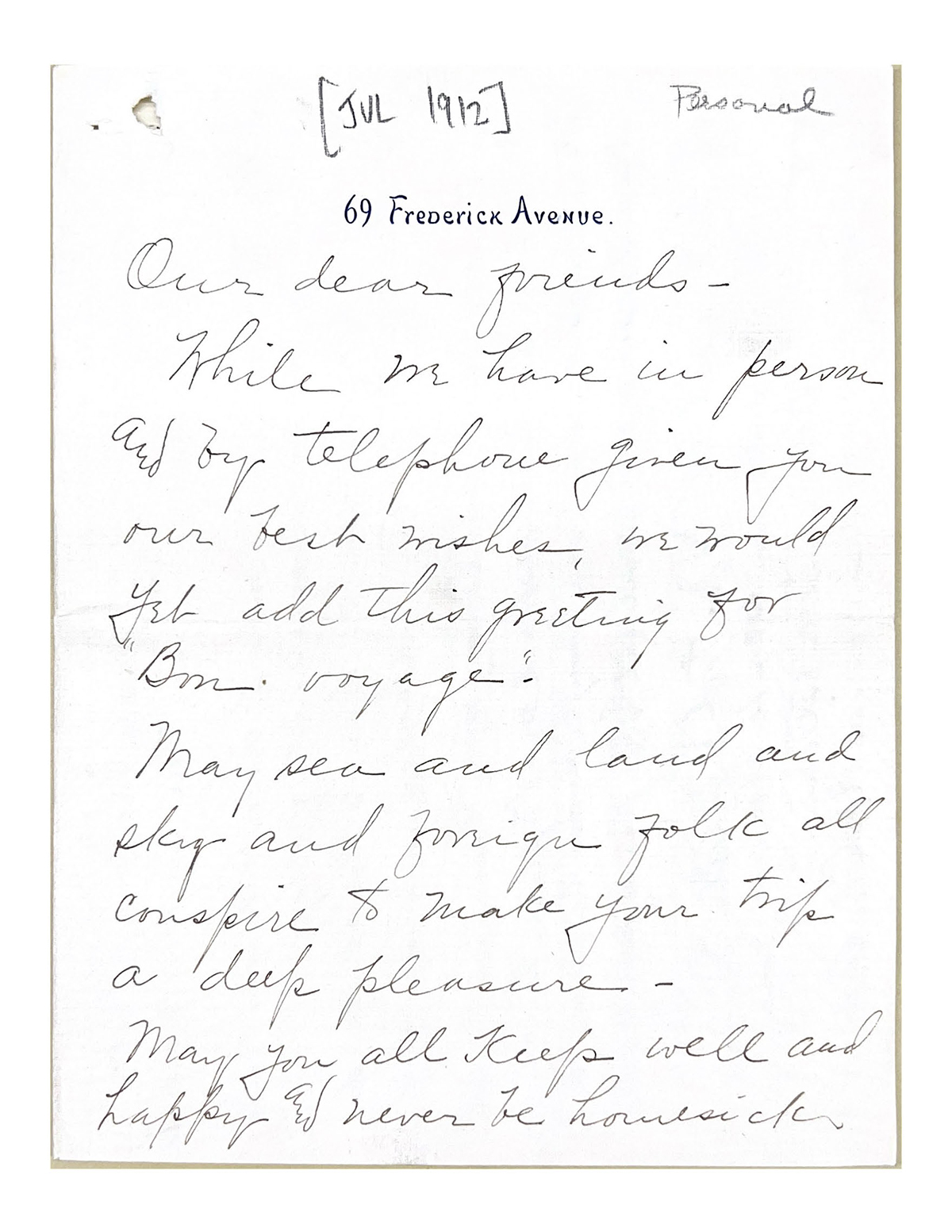
Letter to Clara Ford from her friend Lulu Wilson, July 1912. Accession 1, Box 66. / Image by Lauren Brady
In addition to Clara's diary, we also have Edsel's diary from this trip in our collection.
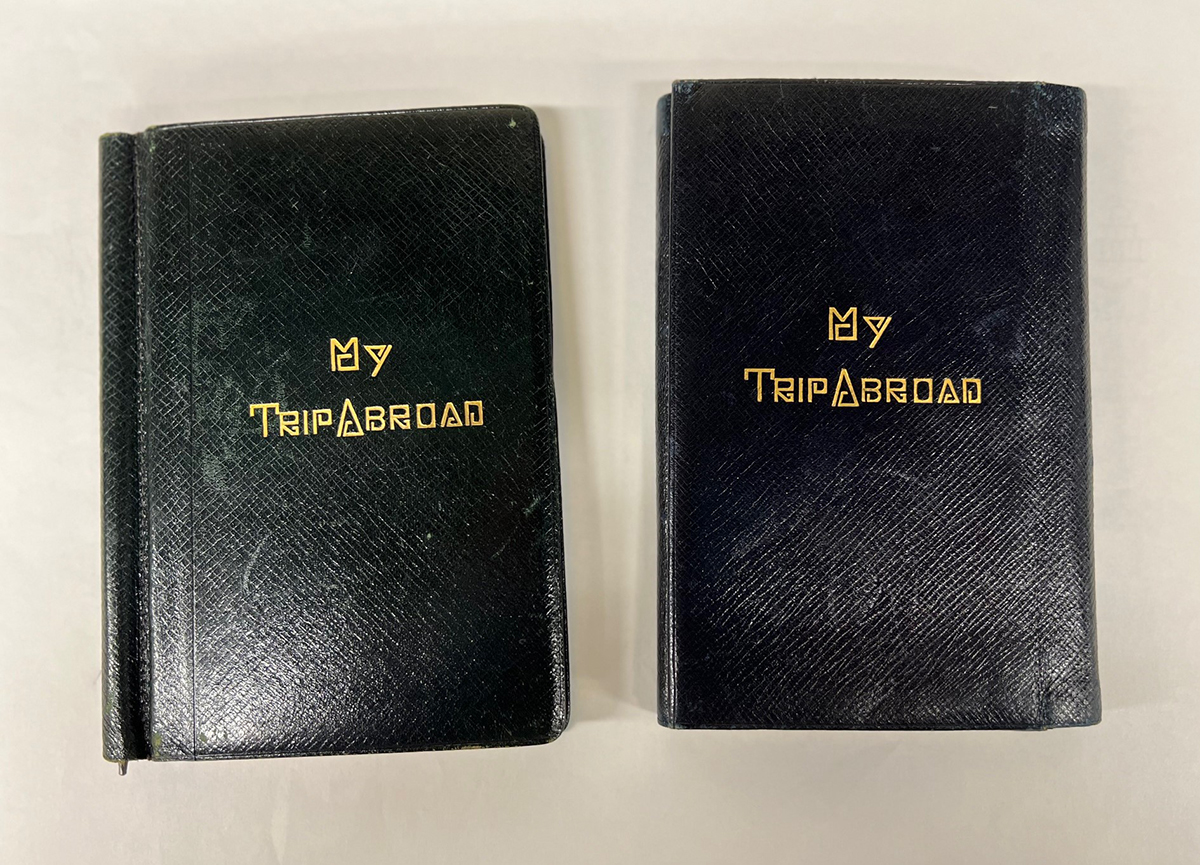
Clara Ford's and Edsel Ford's Travel Diaries, 1912. Accession 1, Box 106. / Image by Lauren Brady
During their travels, they visited Clara's ancestral home. There are parallel accounts of the visit in both diaries. It reads as a meaningful visit for Clara who also describes important genealogical details about her family history that may not have been recorded elsewhere in our archival collections.
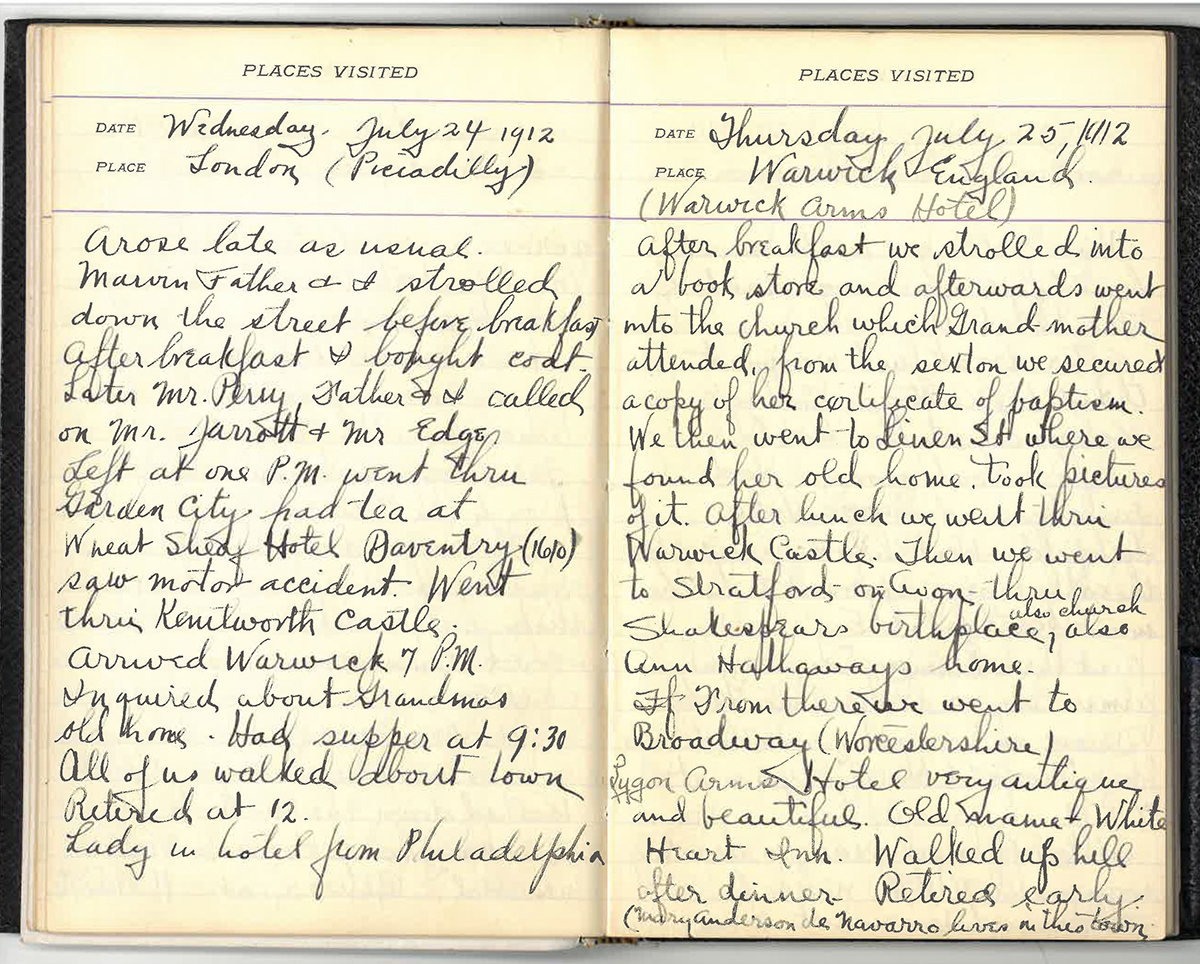
Edsel Ford's Travel Diary, 1912. Accession 1, Box 106. / Image by Lauren Brady
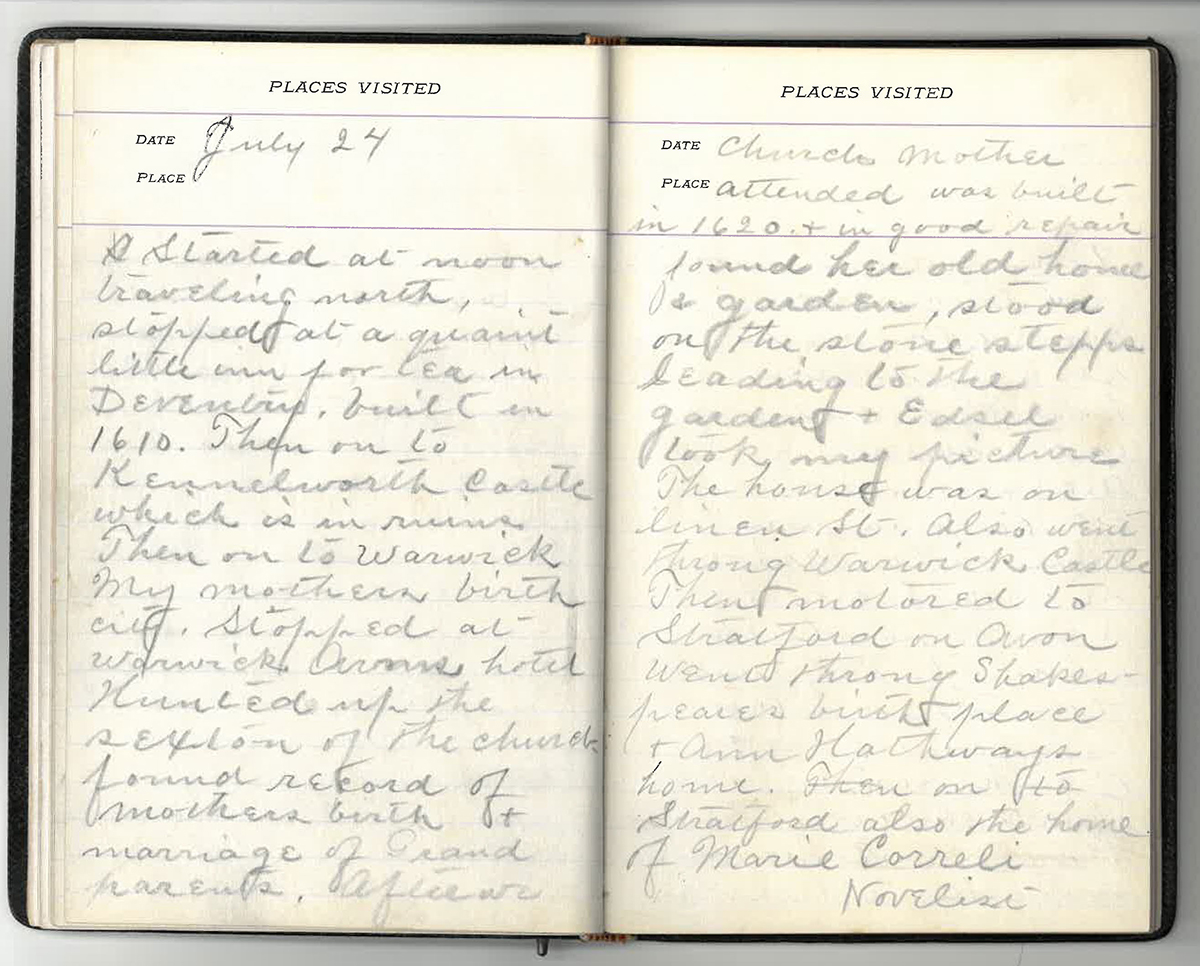
Clara Ford's Travel Diary, 1912. Accession 1, Box 106. / Image by Lauren Brady
The Fords returned to Europe many times, including a trip in 1930 which Clara documented in a diary and a unique photo album. In her diary, Clara makes note of Henry's visit to Buckingham Palace before he departed for the Cotswold region of England where Cotswold Cottage had recently been acquired for Greenfield Village.
This visit received special commemoration in a photo diary with handwritten notes by Clara.
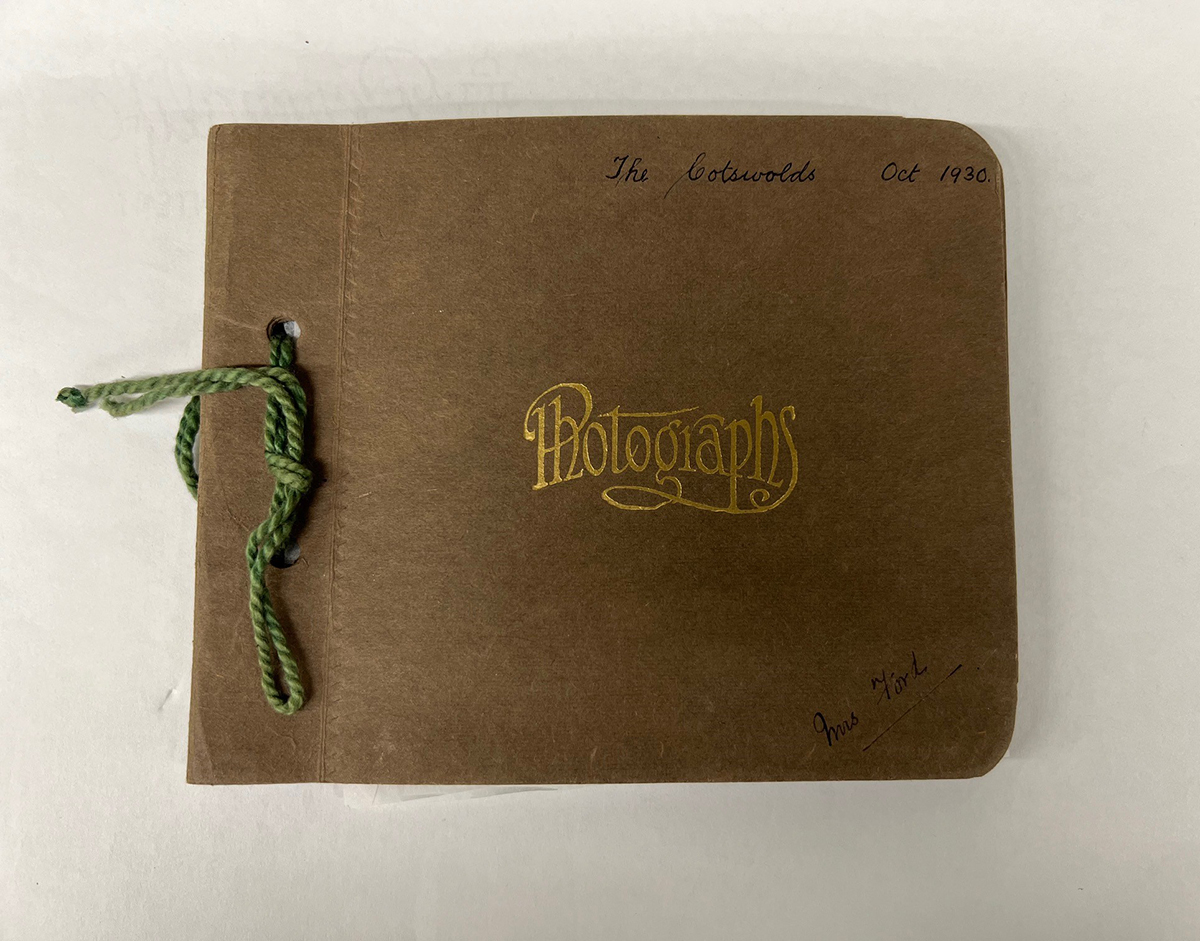
"The Cotswolds" Photograph Album, 1930. Accession 1, Box 106. / Image by Lauren Brady
The album includes several snapshots of their visit culminating with a group photo at the former site of Cotswold Cottage. Clara's notes read like a short story as she describes the photos and recounts details.
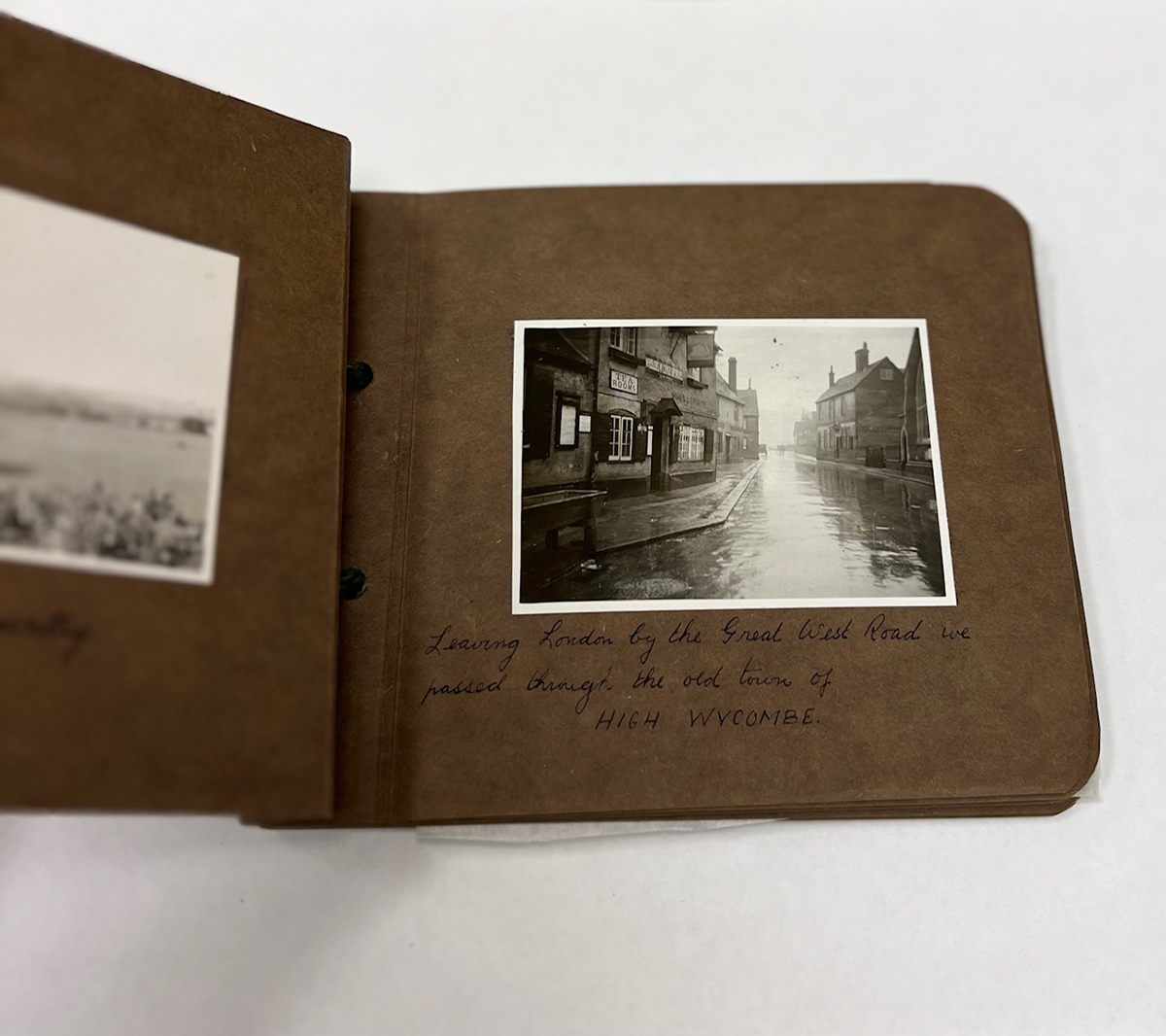
"The Cotswolds" Photograph Album, 1930. Accession 1, Box 106. / Image by Lauren Brady
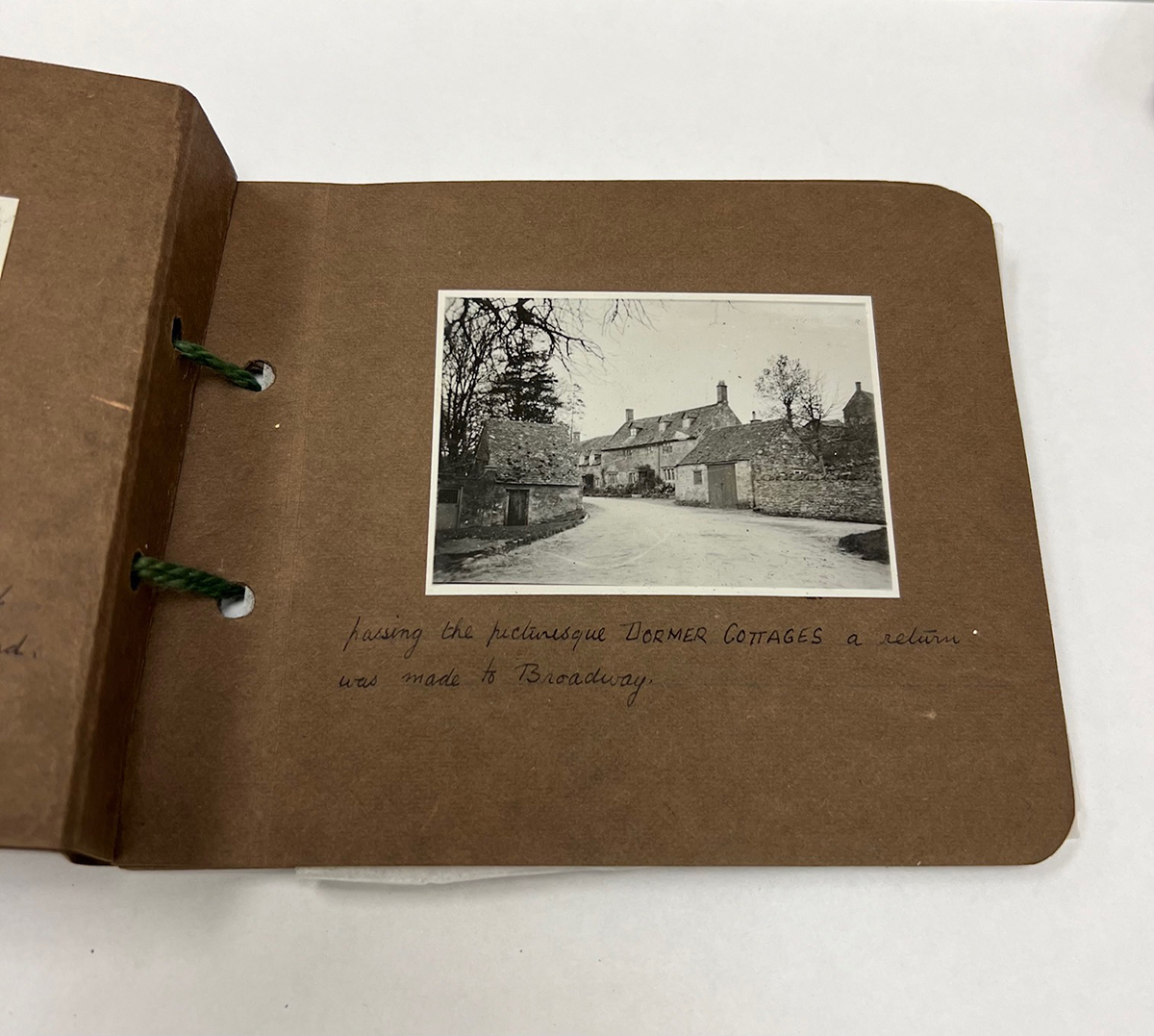
"The Cotswolds" Photograph Album, 1930. Accession 1, Box 106. / Image by Lauren Brady
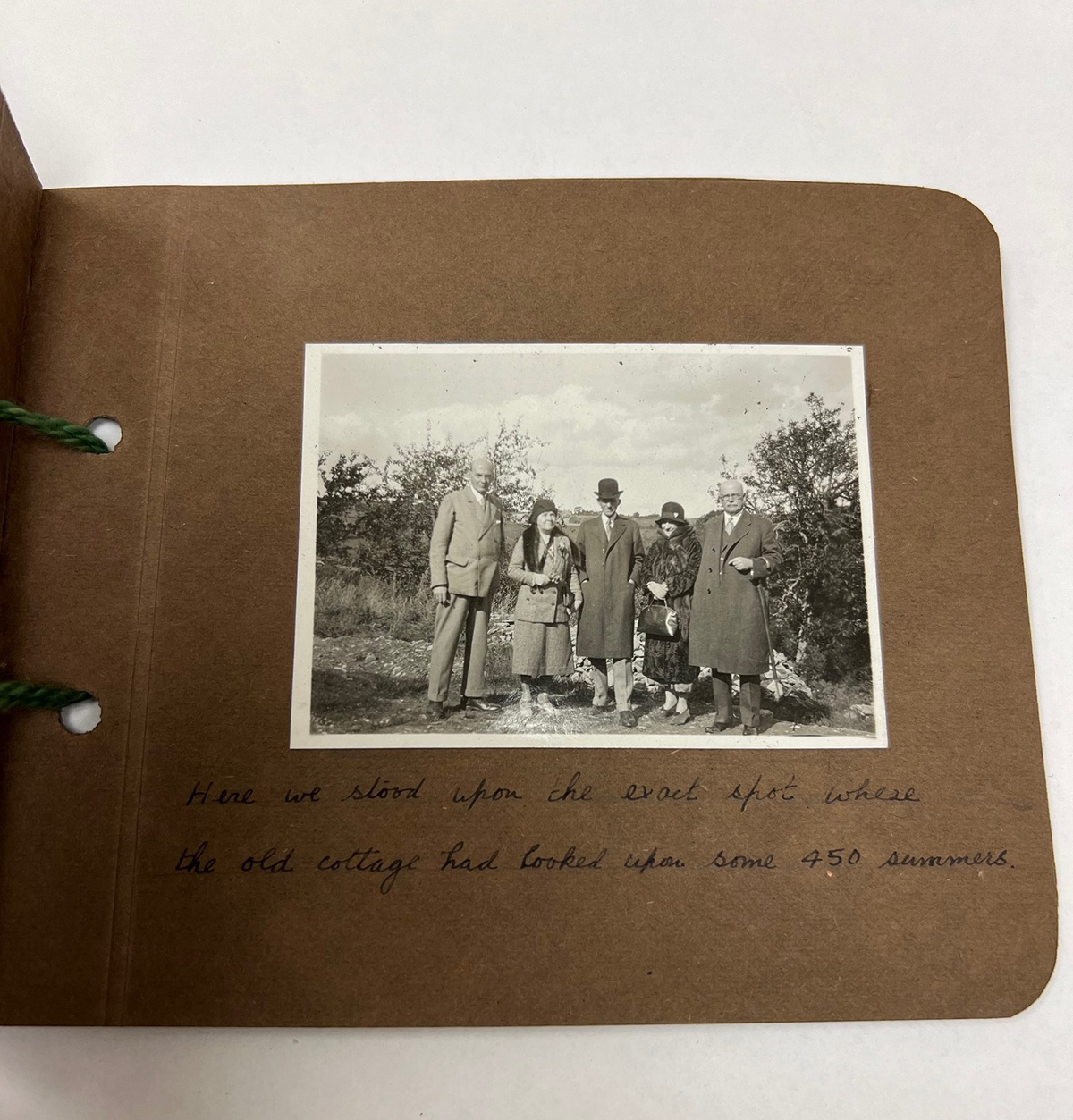
"The Cotswolds" Photograph Album, 1930. Accession 1, Box 106. / Image by Lauren Brady
Clara's diary entries with descriptions of cities and historic sites she encountered are valuable to historians looking for written records of landscapes altered by wars and other major events. Her words help us understand Clara Ford as a historical figure, but they also help us understand a location as it stood at that moment in time.
We are grateful to have these valuable archival records, but it is fun to wonder how a modern Clara may have documented her travels. Perhaps a post like this...
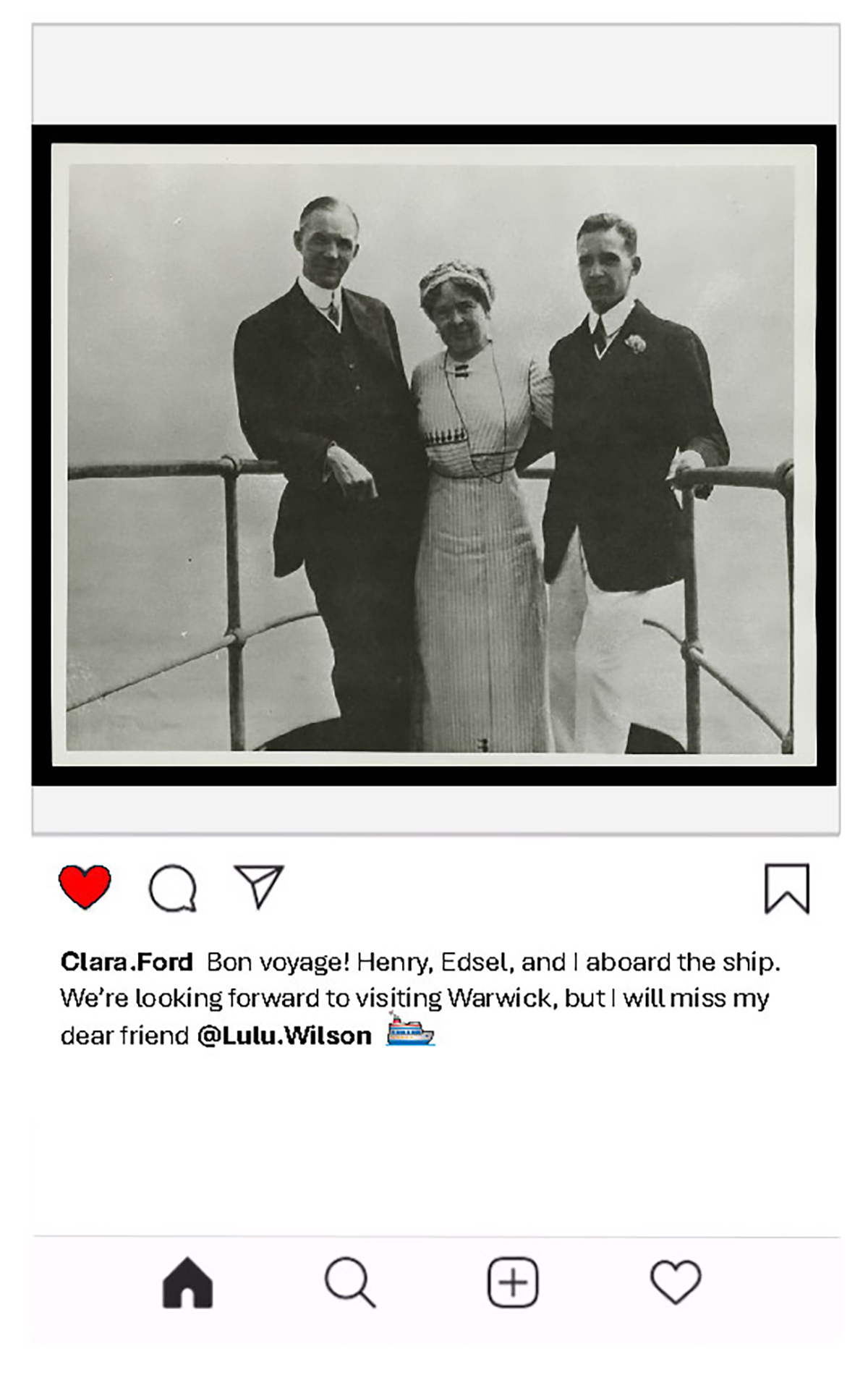
If you have any questions or would like to learn more about our collections, please contact the Benson Ford Research Center at research.center@thehenryford.org.
Lauren Brady is a reference archivist at The Henry Ford.
Edsel Ford, Ford family, Henry Ford, Clara Ford, by Lauren Brady
Mopar Muscle at Motor Muster 2024

This 1970 Plymouth Road Runner Superbird, designed for NASCAR competition, exemplified this year's Mopar Muscle theme. / Image by Matt Anderson
Another summer is here, bringing with it another edition of our popular Motor Muster in Greenfield Village. Part car show, part street fair, and all fun, this year's event brought together more than 600 cars, trucks, motorcycles, bicycles, campers and boats all dating from 1933 to 1978. We like to spotlight a particular theme at each Motor Muster. This year marks the centennial of the first automobiles built and sold under the Chrysler Brand. Obviously, the 1924 model year is too early for our Motor Muster timespan, so we opted to celebrate Mopar Muscle — the Barracudas, Challengers, Chargers, Road Runners and more that made the Chrysler family of makes so popular during the muscle car era. Chrysler introduced the Mopar Brand in the 1930s for its original-equipment parts. ("Mopar" is a portmanteau of "motor" and "parts") But by the heyday of the muscle car in the late 1960s and early 1970s, Mopar was synonymous with high-performance cars from Chrysler's nameplates — especially Dodge and Plymouth.
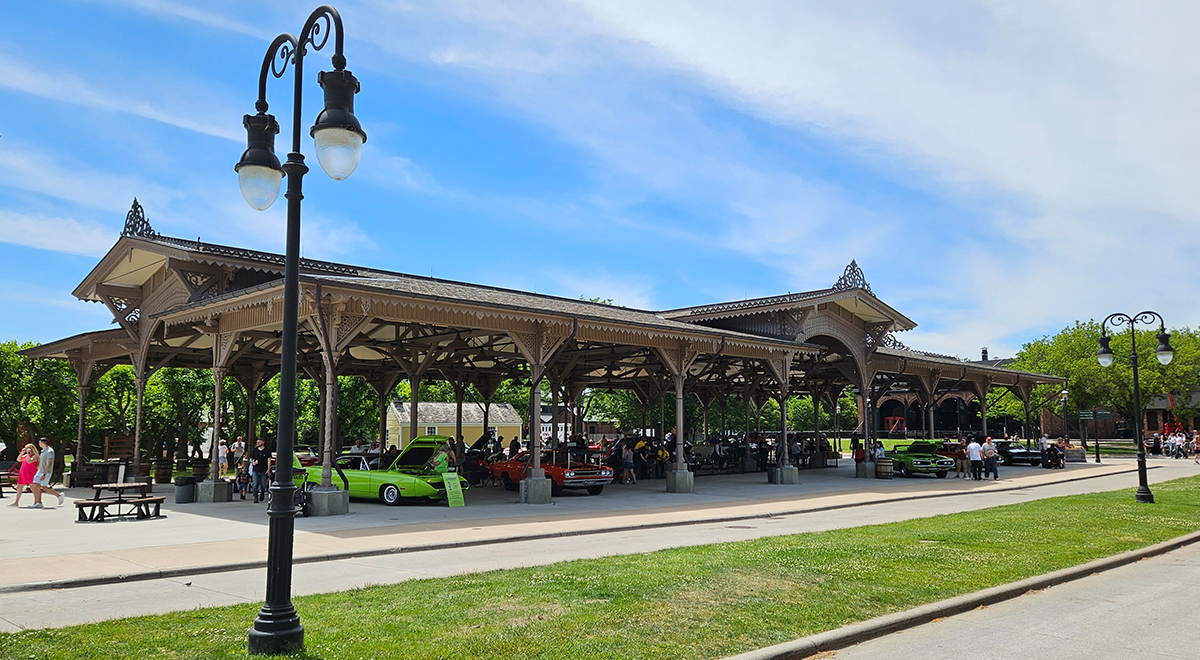
Detroit Central Market was filled with representative Dodge and Plymouth muscle cars, in keeping with 2024's Mopar Muscle theme. / Image by Matt Anderson
Motor Muster routinely brings a stellar turnout of Chrysler-family muscle cars, and 2024 was no exception. This year we featured some of the best in Detroit Central Market. We always like to put interesting pieces from The Henry Ford's own collection in the Market, too. As extensive as that collection is, we don't have any muscle cars from the Chrysler brands. (We do have a 1965 example of the Pontiac GTO — widely considered the first true muscle car.) Instead, we featured three unusual Chrysler products. Our 1937 Chrysler Airflow represented the company's bold step into streamlining in the 1930s. Company founder Walter P. Chrysler had high hopes for the curvy car, shaped in part through wind tunnel tests. The Airflow's interior and mechanical components were equally significant, engineered to provide maximum comfort for passengers. Introduced for 1934 and sold under the Chrysler and DeSoto names, the Airflow attracted unprecedented attention from reporters and customers alike. But the car's many innovations caused production difficulties. Its unconventional looks — particularly its front end — also gave would-be buyers pause. Chrysler toned down the styling in subsequent model years, but Airflow sales still failed to meet expectations. DeSoto's version was cancelled in 1936, and Chrysler's ended after the 1937 model year.
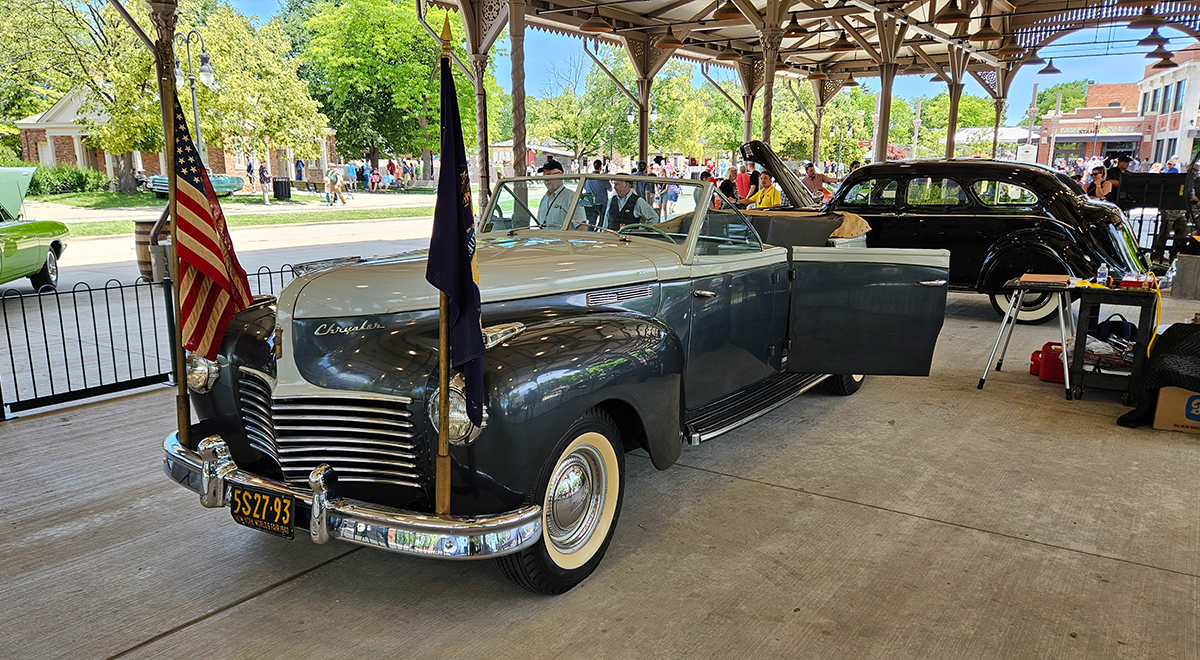
This 1940 Chrysler Crown Imperial Parade Car carried VIPs through New York City for almost 20 years. / Image by Matt Anderson
Our 1940 Chrysler Crown Imperial Parade Car had a happier story. The stately car went to New York City where it served as the Big Apple's official parade car for nearly two decades. More than a hundred dignitaries — politicians, military leaders, diplomats, and notable personalities in the arts, sciences and athletics — rode in the car in ticker-tape parades through Manhattan's famed “Canyon of Heroes.” Dwight D. Eisenhower, Ralph Bunche, Winston Churchill and A. Philip Randolph were just some of the parade car's many distinguished passengers.
Our Chrysler Turbine engine from 1964 was no less important in terms of its technology. Turbine engines use the power of compressed, heated air to turn turbine blades that provide rotary motion to a car's wheels. Mechanically, turbine engines are far simpler than conventional piston engines, and this fourth-generation Chrysler turbine unit boasted 80 percent fewer moving parts. Turbines are also enormously flexible in terms of fuel. This engine could run on anything from unleaded gas to diesel fuel to kerosene to peanut oil. Many companies experimented with gas turbine engines after World War II, but only Chrysler put them into the public's hands. Chrysler built 50 turbine-powered cars and lent them to everyday Americans to get real-world feedback. Users loved the smooth ride and low maintenance but complained about sluggish acceleration and poor fuel economy. Most of the 50 cars were scrapped, but Chrysler gifted a complete car and the showcased engine to The Henry Ford in 1966. Chrysler ended its turbine development program in 1979.

It's not a car, but this late 1970s boat is indeed a Chrysler product. / Image by Matt Anderson
In recent years, Motor Muster has grown to include a small number of boats and outboard boat motors, displayed in their element alongside Suwanee Lagoon. Although it's an often-overlooked part of the company's history, Chrysler manufactured boats and boat engines for some 15 years, from the mid-1960s into the early 1980s. Chrysler Marine (the company’s watercraft division) built everything from small fishing boats to speedboats to sailboats. Some of its marine products shared parts — and even model names — with the company's automobiles. This year's Suwanee Lagoon exhibit included a Chrysler Marine boat built and used in the late 1970s for the company's own testing and development program, as well as a number of Chrysler outboard motors.
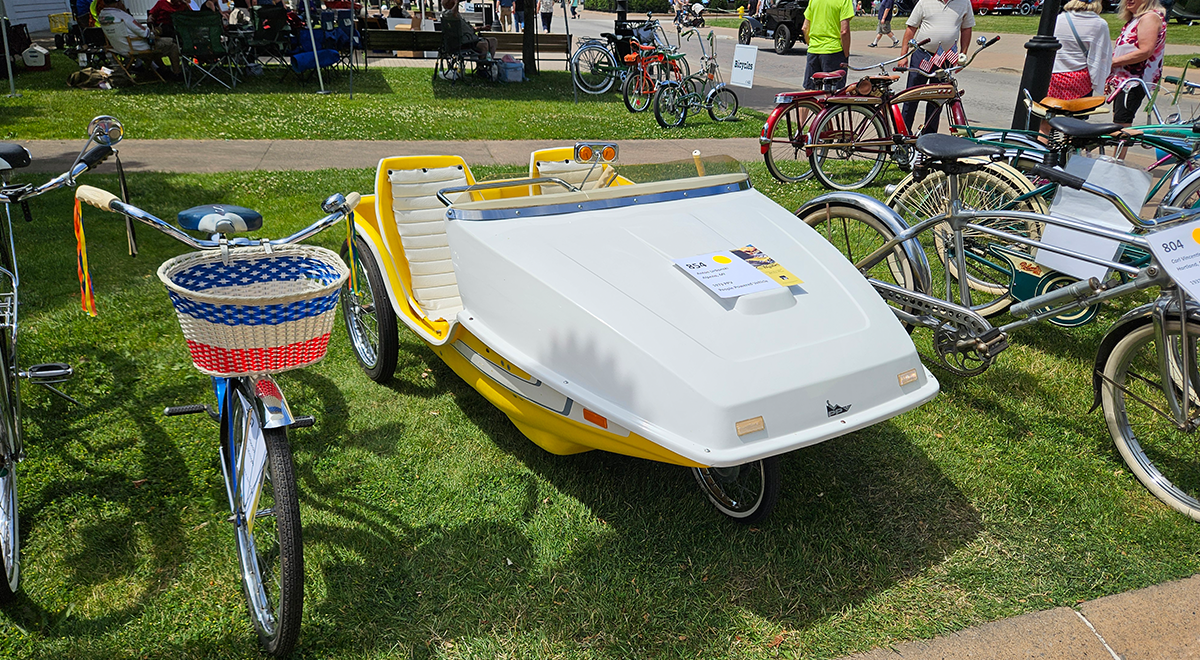
The two-seat yellow and white vehicle seen here was branded a PPV — a people-powered vehicle / Image by Matt Anderson
While the cars are the stars, Motor Muster always features several trucks, fire engines, motorhomes, travel trailers, motorcycles and bicycles, all from the mid-1930s to the late 1970s. Highlights from the pedaled class included a 1973 PPV, or People-Powered Vehicle. These two-seat conveyances were built by the EVI company of Sterling Heights, Michigan, and sold for about $380. They had room for two people (each of whom could help pedal) and space for luggage. Though the PPV had some appeal during those oil-crisis days of soaring gasoline prices, it wasn't practical enough to completely replace the family car.

This 18-foot Holiday House travel trailer offered an alternative for those not fond of Airstream's bulbous look. / Image by Matt Anderson
As is custom, auto camping historian Daniel Hershberger assembled and presented on a wonderful collection of mid-20th century travel trailers and cars near Scotch Settlement School. Highlights included a 1962 Holiday House trailer. Improbably, these trailers were the brainchild of David Holmes, president of the Harry & David mail-order fruit basket company. Fruit baskets were a highly seasonal business, peaking in the fall and through the December holidays. Holmes, looking to keep his employees and facilities busy during the rest of the year, hit on the idea of building travel trailers, which sold best in spring and summer. Holiday House offered trailers in 17-, 19- and 24-foot lengths, with gleaming aluminum skin over wooden frames. Unfortunately, the idea didn't work as well as Holmes had hoped, and Holiday House trailers were only produced for a few years. Recently, the brand name was revived on modern trailers built by another manufacturer.
In addition to Mr. Hershberger's presentations, two other experts offered talks throughout the weekend in Martha-Mary Chapel. Jim Johnson, Director of Greenfield Village and Curator of Historic Structures and Landscapes, spoke about the unique challenges of driving during World War II, when new cars weren't being manufactured and rubber and gas rationing curbed Americans' non-essential travel. We also had a special guest presenter. Richard J.S. Gutman shared stories and photos from his lifetime studying, visiting and preserving America's roadside diners. Mr. Gutman's timing couldn't have been better — he and his work are the subjects of the current Dick Gutman, DINERMAN exhibit in the Collections Gallery in Henry Ford Museum of American Innovation.
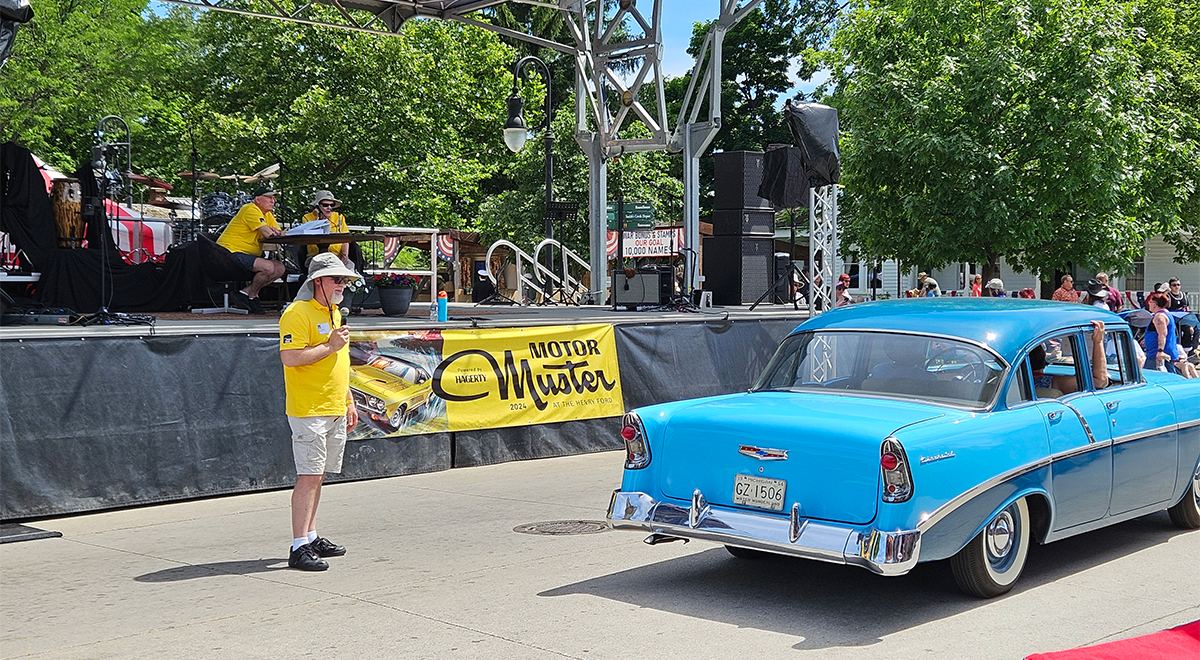
Historians Roger Wojtkowicz, Jim Wagner and John Wagner provide commentary on a 1956 Chevrolet during pass-in-review. / Image by Matt Anderson
Beyond the special presentations, Motor Muster 2024 saw the return of our popular pass-in-review sessions, in which expert historians offer insights on participating vehicles as they drive past the Main Street reviewing stand. Automobiles were broken into separate sessions by decade, while commercial vehicles, motorcycles, bicycles and race cars each had their own dedicated pass-in-review programs. Naturally, we held special Mopar Muscle sessions on both Saturday and Sunday to celebrate this year's theme.
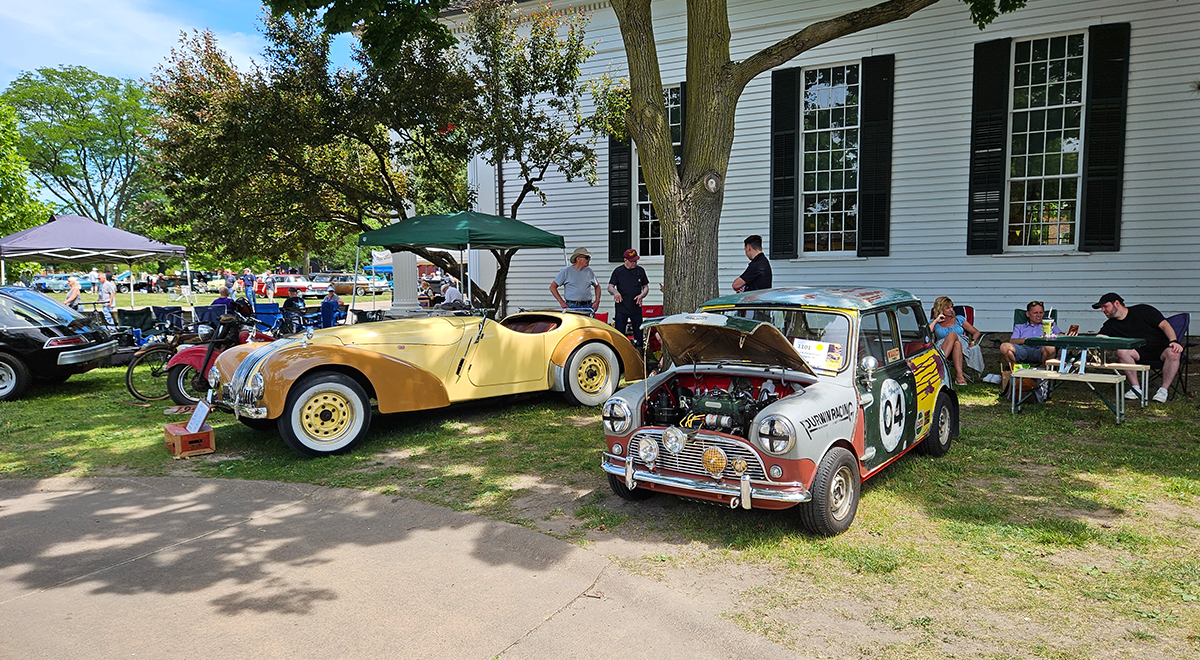
Competition cars like the 1941 Allard K1 at left and the 1962 Austin Mini Cooper at right – British vehicles both – sat near Town Hall. / Image by Matt Anderson
If all those motor vehicles and programs weren't enough, Motor Muster also featured a range of historic vignettes keyed to each of the show's five decades. Timeless Blues music was heard from the porch of the Mattox Family Home, the Village Cruisers vocal group performed a medley of 1950s hits at the Lodge, and the Together Band provided a concert of 1970s classic rock on the Main Street stage on Saturday evening. And yes, there was Historic Base Ball, too, as Greenfield Village's own Lah-De-Dahs played three games over the weekend.
The whole event was capped on Sunday afternoon with our awards ceremony. Visitors got to choose their favorite vehicles from the various decades through popular choice voting. We also gave two Curator's Choice prizes for unrestored vehicles. This year's unrestored winners included a 1951 Ford Deluxe and a 1973 Oldsmobile Cutlass S. The full list of winners is available here. The ceremony provided a perfect end to another great show.
Matt Anderson is curator of transportation at The Henry Ford.

